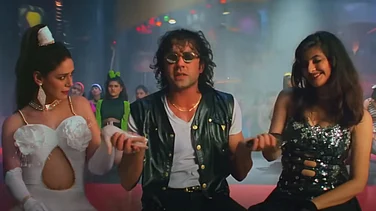On a November evening, just after the sunset, when the golden tint of the desert city of Jaisalmer transitioned into the magical post-evening hues, a select group of guests, art enthusiasts and diplomats from around 50 countries headed towards a destination in the middle of nowhere. As they moved away from the touristy hustle and bustle, they had a rendezvous with the starry desert sky and silence. Amid pitch darkness, a row of lanterns led them to the ethereal Mool Sagar Palace, built in 1815 as the summer retreat for the royal family of Jaisalmer.
Inside the complex, dimly lit tea candles gave a mere glimpse of the palace. Light and shadow were playfully teasing each other. Just like sound and silence were. In one large jharoka, the manganiyars—the musicians of the desert—were creating soulful melodies through voice and instruments which were unamplified to retain the naturalness of the music so that it felt intimate with the surroundings. When the music faded in intervals, one could hear the elements of the night landscape—crickets, dogs barking at a distance, punctuation of truck horns zooming past on a barely visible highway, and silence—the kind of silence that transports you to an imaginary world, or, forces you to open the floodgates of memories. This was just a precursor to the juxtaposition of sound and silence that the guests and locals were to witness for the next two days (November 3-4).
“The silence and isolated sounds found in the desert are a perfect platform to dream,” says Sarah Singh, the founder and creative director of the international art salon Panorama Editions, which organises sight-specific exhibitions. After the first two editions at Patiala (2018) and Jodhpur (2019), the Jaipur edition had to be called off because of the pandemic. It was in 2023 that the royal family of Jaisalmer invited the award-winning artist and filmmaker to organise a unique experience as part of the third edition of Panorama. Titled Silent/Sound SAFARI, the conceptual theme of this edition was sound as art and experience.
It was in 1992 that Singh first visited Jaisalmer with her mother. One night, they were sitting in their tents pitched in the desert. In between the conversation, they heard a faint sound, which was coming from a far off village. Because the landscape was wide open, the sound was able to travel uninterrupted. “Though we could not see the village because of the surrounding darkness, we could hear its presence. The sound was so evocative and the moment so enigmatic that it has stayed with me all these years. It was a real life example of how provocative sound can be,” narrates Singh.
This desert memory inspired her to focus on the concept of sound and silence—creating a circle with the Jaisalmer of her past and present. “We think of the desert as a blank slate—not visually very rich or having a lot of layers of sound when, in fact, there is much to be experienced at minute levels. The open landscape allows the sound to freely travel and it is most often experienced as isolated layers—allowing you to hear the dialogue between sound and landscape,” says Singh. One could listen serenely to the soft, orchestra-like bells of a roaming herd of goats out in the middle of nowhere, where no other sound occurs at the same time to interrupt this floating cloud-like audio, elaborates Singh.
Among the many experiences involving sound and silence, she chose to showcase two in the form of live art performances at Mool Sagar Palace.
How sound adds life to a ‘still photograph’ was witnessed through a tableau of the performance titled ‘There is an Ocean in the Desert’. In May 2023, Singh had photographed a child sitting assuredly atop a camel. This striking moment of real life inspired the first tableau which aimed to explore the evocation of sound through silence in a local context.
A flight of age-old, uneven stone staircases led the guests to this unusual performance venue. A camel stood still inside an empty swimming pool—a possible symbol of what the constantly changing climate might bring upon us. A young boy wearing red attire sat assuredly atop the camel. An old man wearing a skullcap was holding a lantern in one hand and the rope tied around the neck of the camel in the other. He looked off into the distance, beyond his current reality. Two other locals were holding large megaphones at starkly different angles. Through their exacting body language, sound was represented through this visually potent stance; this staging actually had a “soundtrack” that was coming from a corner of the swimming pool through a makeshift handmade speaker picked from a local market in Jaisalmer. It was playing 1970s disco music which created a unique juxtaposition of sound with silence—turning this staging of a local montage into a quixotic imaginary world.
A person sporting a beard and wearing a fuchsia pink lehenga-choli and anklets reclining at the edge of the swimming pool moved seductively around the characters in the swimming pool and gradually exited the scene, as a kind of dream-like lead into the direction of the next performance. From the pool tableau, the guests continued onto the next staging by walking through a barren field—away from the 19th-century palace, towards the 500-year-old stepwell—and the disco music gradually felt far away, harking back to Singh’s memory from 1992.

Under the starry desert silence, the stage was set inside the stepwell with a cast of 14 choreographed through two simultaneous performances—Napoleon’s Caged Descent and A Caged Relationship. Much of the cast were first-time performers, including four members of the LGBTQ community, a herdsman and his two goats, a nomadic farmer, and a stone carver. Two seasoned performers anchored the two separate plays—Hesh Sarmalkar as Napoleon encumbered by an extraordinarily long cape, and Srilaxmi wearing a mix of old and new mirror work clothing as she navigated the stage, representing someone who appeared unaware of how to exit but also on the verge of escape.
All 14 members were strategically positioned against the undulation of the ancient stepwell. Amid episodes of silence, the four “girls” sang and danced with their anklets providing the requisite music; Srilaxmi tirelessly moved from one corner to the next with the jangling sound of bells her only voice; and Napoleon burst onto the scene in a fit of defiance but was relegated to the dragging of his heavy cape with an intermittent whistle as a reference to his faltering command.
As the two performances came to a close, there was silence. Suddenly, outside of the edge of the stepwell, the sound of an old man breaking stone with a sledgehammer reverberated amid the dead of the night and brought the gaze of the audience out of the stepwell. This stark action and sound of the stone cutter referred directly to the landscape as the famous Jaisalmer stone is found right here and is important on a local level. Incorporated in architecture across India, it is emblematic of the ancient trade routes which Jaisalmer used to be part of.
The landscape and real-life experiences inspired Singh to bring to Jaisalmer unique experiences from across the world—sound and silence, after all, are universal and timeless phenomena. Thus began the process of collaborating. “Working with digital audio files was a practical creative decision which worked well for all the participating embassies and arts organisations,” says Singh.
Built in 1156 AD, the majestic Jaisalmer Fort Palace Museum was chosen as the destination to showcase the sounds and silences. “Forts are a unique part of our history. By choosing such places as venues for sight-specific art salons, you get to connect with the history of the place in a formal but temporary approach. This momentary dialogue adds another layer to the ongoing history of the place,” says Singh.
For the first time, the museum in the 12-century fort palace—started by Maharawal Brijraj Singh and Maharani Raseshwari Rajya Laxmi in 1998—opened its gates to host the contemporary art exhibition alongside its permanent collection. A ‘museum’ within a museum. “The experience of collaborating with dozens of countries and hosting the international art salon was overwhelming,” says Chaitanya Raj Singh, Maharawal of Jaisalmer.
The idea was to create a unique experience for the largely international audience invited for the art salon, as well as for the locals. “I have a special connection with Jaisalmer and was keen to promote the golden city,” says Siddhaant Mohta, who collaborated with Singh to bring 20 embassies and art organisations together. Sound art from Hungary, Norway, Portugal, Sweden, Dominican Republic, Italy, Guatemala, Switzerland, Brazil, Lithuania, Ireland, India, Spain, Greece, UK, Germany, New Zealand, Mexico, and the US were showcased in the world’s oldest living fort.
The exhibition took one on a journey through a diverse audio landscape—from field recordings across Mexico to a black and white German film with a highly structured rhythm, to the distant sounds of an imaginary land as explored by a work from Sweden to the complex silence evoked by climate change from India.
“Soundscapes of Mexico”—supported by Mexico’s National Sound Library—aimed to rescue, by recording with cutting-edge techniques and technologies, the characteristic sounds of the country. The elements of sound included the metro subway, cathedral bells, soundscapes of Michoacan, the sea, and the nocturnal sound environment in the Mexican region.
In another room, centuries-old, human-scale storing vessels made of camel skin dominated the floor, a unique glimpse into the local history. Presented in this room in dialogue with these historic vessels were historic short animations by Len Lye (1901-1980), a sculptor, filmmaker, kinetic artist, painter, writer and theorist from New Zealand. This dialogue of “dual histories” worked well with their contrasting tones—the old vessels in various states of being against the light-hearted playfulness of the 1930s animations with their unusual sound designs.
There was also a lounge-like ‘sound room’ where one could sit and listen to the works of 11 artists from different parts of the globe. It was a unique experience for Jaisalmer as the silence of the desert was recreated indoors with references to taking a ‘desert safari’ found in the psychedelic patterns on pillows and bolsters. In the adjacent room were the works of four female filmmakers—all extremely different explorations of sounds, including Lacerate by Greek artist Janis Rafa shown at the 2022 Venice Biennale.
Depicting the problem of climate change was captured in contemporary Indian artist Vibha Galhotra’s single-channel silent film Cleansing. Her artwork was an amalgamation of her concerns with the elements of air and earth and examined the phenomena of escalating dust levels due to the rapid rise in mining and transport.
The film captured the very simple and mundane act of cleaning a plant. Galhotra could see that the layer of dust mixed with the oily surface of leaves had shielded the plant from the processes of photosynthesis, respiration, transpiration and absorption of phytotoxic gaseous pollutants.
Her artwork was displayed in the museum alongside the permanent collection of centuries-old sculptures of gods and goddesses, driving home the point that nature is divine.
Talking about the juxtaposition of sound and silence, Galhotra, says: “Sound, a dual force of disturbance and therapy, disruption and spirituality, serves as our paramount sense, guiding us through the intricacies of our outer and inner worlds. It embodies an inner pleasure, an experiential delight.” On the importance of silence, she adds: “In the symphony of existence, even silence possesses its own sound, with pauses becoming integral notes.”
In contemporary society, sound has been reduced to a chaotic jumble where its meditative or evocative qualities are not given much space, especially in this visually dominant world, says Singh. “This was the impetus behind curating the art salon around experiments with sound —to allow us time and space to engage with sound which expands our expression and approaches to co-existing,” she adds.
Swati Subhedar in Jaisalmer
(This appeared in the print as 'The Sounds of Silence')



























